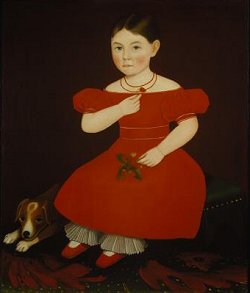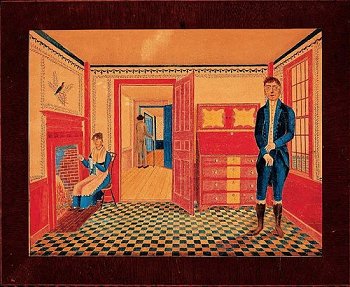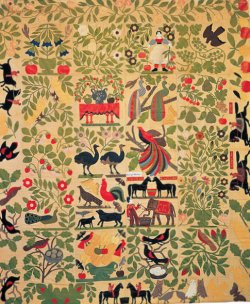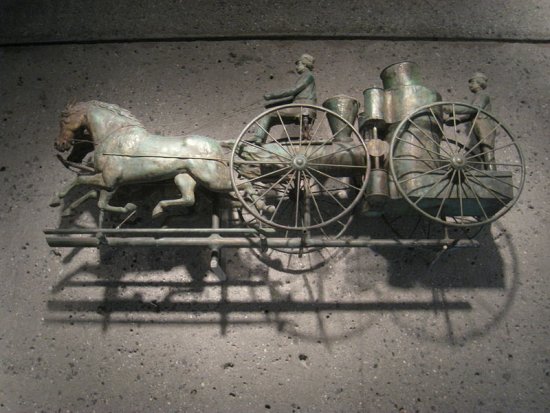Americans are tearing round sale-rooms in the search for their own folk art. Andrew Solomon runs across a boom in samplers and paintings of children and pets.

Ammi Phillips, Portrait of a Young Girl in a Red Dress, ca. 1835. Exhibited at the Terra Foundation for American Art.
American Art is burgeoning; new sales records are being set especially in the field of American folk art. Sotheby’s just took the record for an American folk painting from Christie’s, who held that record for two years for the beautiful Ammi Phillips Portrait of a Young Girl in a Red Dress, which sold for $682,000 in 1985; Sotheby’s sold John Brewster’s double portrait of Comfort Starr Mygatt and his daughter Lucy for $852,500 this January. The record for a needlework sampler is held for one stitched by Ruthy Rogers, at the age of ten, which brought $198,000 at Robert W. Skinner, a Massachusetts auctioneer; an American quilt from Baltimore was sold at Sotheby’s for $176,000 last year; a copper weather-vane of 1882, in the shape of a locomotive and tender, sold for $203,500 at Skinner.
Every nation tends to collect native art whose charm is lost on foreigners; Americans and Europeans tend to think that the inclination of the British to collect second-string British painters is rather endearingly nationalistic. For many years, the American fondness for its folk art has been seen in just this light, and non-Americans have found it curious that there was a market for what seemed to be technically rather incompetent pieces of art. And such works, like the heritage works of any nation, brought prices substantially lower than might be expected for work sold to an international market.
But this is no longer the case. The Japanese have started buying American folk art, and at this January’s sale at Christie’s walked away with an enormous number of folk marine paintings. The French have evinced a great admiration for American quilts, and there are about twenty dealers in quilts in Paris today. The British are joining the foray rather cautiously, but have shown some interest in quilts and, interestingly, in both furniture and paintings.

Interior of John Leavitt’s Tavern, by Joseph Warren Leavitt, c. 1825. Exhibited at the American Museum of Folk Art. Source: Wikimedia Commons.
Defining American Folk art can be a tricky business. Nancy Druckman, the chairwoman of the American folk art department at Sotheby’s, says that, essentially, folk art is “the artistic creation of people not formally trained.” Sotheby’s American folk art department, which currently holds most of the more important records, has existed for fifteen years, and has helped to create the background for much of the current interest. Until this year, Christie’s sold American folk art through the American paintings and American decorative arts departments, but this year they have recognised its status as a separate kind of art, and have created an American folk art department. John Hays, head of that department, says that folk, art does not need to be defined. “It’s there in the title,” he explains: “It’s art from the people; the artists can be academically trained or not academically trained, but their concerns are the daily concerns ‘of the people’ and are not designed to cater to an elitist circle. Folk art gets into the heart of your average person.”
The first serious collector of American folk art was Electra Havemeyer Webb, whose mother was intimate with many of the Impressionists and who, marrying as she did into the Vanderbilt family, entered another long line of fairly academic art collectors. She started collecting folk art near the beginning of this century, perhaps because she was unwilling to compete with the traditions of both her families, and started the Shelburne Museum, one of the most important American folk art museums in the world. But it was some years before there was a serious collecting public, and the market has really taken off since the 1973 sale of the Chrysler Garbisch collection at Sotheby’s.
The market for American folk art now has been bolstered by the recent opening of the Hirschl & Adler Folk Art Gallery. Long established as one of New York’s most important dealers in fine arts, their imprimatur on the field of folk art has helped to dispel the misapprehensions of some of the American public that folk art is a less “artistic” area than are the fine arts. Stuart Feld, of Hirshchl & Adler, has paid several of this year’s record-breaking prices, apparently unafraid that these prices could reflect a temporary inflation of the market. “Prices are going up,” explains Nancy Druckman at Sotheby’s, “because there are fewer and fewer fine pieces offered for sale, and because there are more and more people who want them. And there will continue to be more people.”

Bird of Paradise quilt top, 1858–1863. Exhibited in the American Folk Art Museum. Source: Wikimedia Commons.
John Hays, of Christie’s, is himself rather like a piece of American folk art. He is lucid and straightforward and earnest and dignified. “Folk art is a lot less intimidating than the art forms we’re accustomed to, and so the folk art market is an open one,” he says. It is striking that the people who collect folk art are often very much like the people who created folk art, people with an intuitive aesthetic. The most exciting thing seems to be the originality. John Hays explains: “For the first time in my experience of American art” — he was trained as an expert in “high-style” American furniture — “I feel totally unburdened by the British and European designs that have guided us so much of the time. All of a sudden it’s like a window has been opened and you’re totally free of having to deal with the English or French counterpart. That’s very exciting; perhaps it’s nationalistic, but all of a sudden you’re there, you’re dealing with the real thing. Collectors,” he adds, “are often regionalistic, so that Rhode Island pieces will often sell to people from Rhode Island, Virginia pieces to Virginia people, and so on.”
The difficulty of assigning value to works of folk art is enormous, because the rigorous articulation of the locus of value is only beginning. “You have to be careful,” explains John Hays, “not to give false value to things that aren’t good art. You can’t drag in every pitchfork and say, “Ah! Folk art!” It’s also a big mistake to call second-tier academic painters, whose work fails at the academic level, folk artists. The criteria are entirely different. The real folk interest in is colour and pattern and form and whimsy at a level at which second-tier academic painters wouldn’t be thinking of.”
But even when a piece has been established as folk art, the question of its value is clouded. In paintings, for examples, “the golden age came between 1799 and the 1840s, before the birth of photography,” says John Hays. “In these works, there’s an iconography,” he explains. “People sell better than landscapes. Children sell better than their parents. If there’s a child with an animal, that’s better yet. If there’s something humorous going on with the child and the animal — if the child is pulling a cat’s ear, for example — that’s best of all. If you know who the sitter is, if you know where it was painted, if you know something about the family, all that helps. But even more than in other areas of art, there’s a tendency to step back and look at the piece and just see how pleasing it is.”
In American needlework, the factors are slightly different; most was done by girls between that ages of six and eighteen, to prove their abilities before marriage. The pieces are interesting because their sociological function fascinates us, and because their function — usually to catch a good husband, sometimes to commemorate someone’s death — is so palpable in them. Marguerite Riordan, one of the most important American needlework dealers, explains that “intrinsic beauty and rarity” are the two most important characteristics, but that “subject matter, composition, technical proficiency and condition are primary issues. Provenance is always a factof.” She adds that “a wise rule is always to emphasise discipline over emotion.”
Part of the confusion comes from the variety of material in the American folk art field. But always, explains, John Hays, “Pattern and a spontaneous manner will do better than stiffer or more hard-boiled work. It’s easier to love a work that’s humorous and beautiful than one that’s not, or even a work that’s wonderfully macabre, if that’s your taste; people live with their folk art. They don’t collect it to store. And the collectors depend on subjective criteria. Why not be subjective? We all are.”

Weathervane of steam fire engine, Harris & Company, Boston, circa 1880. Exhibited in the American Folk Art Museum. Source: Wikimedia Commons.











